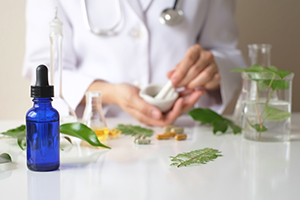Botanical Medicine for Cirrhosis in North Hollywood, CA

Your liver delivers vital nutrients to your bloodstream, while filtering out harmful toxins. This is why a liver imbalance can profoundly damage your overall health. Botanicals – substances extracted from plants – have been used for centuries all over the planet to biochemically correct enzyme and hormone imbalances in the liver.
When liver tissue is highly inflamed from alcohol abuse, hepatitis B or C , scar tissue begins to replace healthy tissue, a process known as hepatic (liver) fibrosis. Once this scar tissue replaces most of the liver a patient is diagnosed with cirrhosis.
While cirrhosis cannot be reversed, there are numerous herbs that can prevent, reduce and even halt fibrosis. About 65% of patients in Europe and the U.S. depend on herbal remedies for the treatment of liver dysfunctions1. To learn more about herbs for liver cirrhosis, speak with a specialist in North Hollywood today by calling (424) 365-1800 or contact Dr. Jeremy Fischer online.
Cirrhosis symptoms
Symptoms of fibrosis usually don’t present until damage reaches the cirrhosis stage, and the liver is no longer able to remove toxins from the blood.
Talk to your healthcare provider if you are experiencing the following symptoms:
- abdominal pain
- loss of appetite
- fatigue
- nausea
- easy bleeding
- weight loss
- jaundice
- itchy skin
- swelling in the legs
How medicinal botanicals function in the liver
The following biochemicals stimulate liver fibrosis:
-
extracellular matrix (ECM) proteins: support your cells structurally and biochemically
- collagen is the most abundant ECM protein
- hepatic stellate cells (HSC): activate fibrosis
- transforming growth factor β beta 1 (TGF-β1): stimulates HSCs to aid in wound healing and triggers the production of ECM protiens1
- platelet-derived growth factor (PDGF): these increase the number of HSCs1
- tumor necrosis factor (TNF-α): secreted by immune system cells; stimulates inflammation1
- matrix metalloproteinase-2 (MMP-2): an increase in this enzyme’s activity is related to the destruction of liver tissue and replacement of collagen1
Alpha-smooth muscle actin (α-SMA) protein is a reliable marker for HSC activation1.
The following medicinal botanicals help regulate these fibrosis markers:
Milk thistle
Milk thistle contains an antioxidant called silymarin which caused the death of HSCs, improving liver function for hepatitis B, C and D patients in clinical trials. Practitioners treating acute and chronic viral hepatitis , toxin-induced hepatitis, and alcoholic hepatitis prescribe milk thistle to:
- promote enzyme formation
- increase bile production
- decrease inflammation
- soothe mucous membranes throughout the body
Licorice root
The glycyrrhizic acid found in the roots of the licorice plant has anti-inflammatory, antiviral, and antiallergic properties – it helps prevent the death of hepatic cells. The glycyrrhizic acid in Stronger Neominophagen C IV licorice treatment has reduced death rates of hepatitis B and C patients while improving hepatitis C mouth sores.
Korean Red Ginseng
The National Institutes of Health published studies that show this root can mitigate fibrosis by inhibiting the activation of HSCs, lowering ALT levels, and regulating bilirubin levels.
Curcumin
Turmeric is an herbaceous plant belonging to the ginger family – a chief ingredient in almost all Indian dishes. The yellow compound curcumin which is derived from the plant extract of turmeric has been used for centuries in Ayurvedic and Chinese medicine.
The journal Molecular and Cellular Endocrinology found that curcumin inhibits stellate cell activation by suppressing TGF-β1 and preventing the build-up of ECM.
Green tea catechins
The epigallocatechin-3-gallate found in green tea has been shown to suppress MMP-2. Studies have shown that this powerful antioxidant can help fight a wide array of viruses, including herpes, influenza and human immunodeficiency virus2.
Red sage root
The root of the red sage (salvia miltiorrhiza) plant contains salvianolic acid which has been shown to:
- suppress TGF-β1 and α-SMA
- reduce ALT and AST activities
- inhibit type I collagen
- down-regulate TGF-β1, TIMP-1 gene expression and MAPK activity3
Sacred lotus
This flower which grows in murky waters across India, Vietnam and other Southeast Asian countries contains armepavine. When extracted properly this enzyme can reduce TNF-α and α-SMA. It provide hypoglycemic, anti-fungal, anti-inflammatory, anti-pyretic, and anti-anxiety properties.
Monnier's snowparsley & cnidium fruit
Both of these plants contain osthole, a major bio-activity compound that has been shown to ameliorate hepatic fibrosis and suppress the activation of HSC. Studies have also demonstrated its antitumor effects4.
Wild leadwort
The root of this flowering plant native to Australia and India contains plumbagin, which decreases production of type-I collagen, downregulates activation of HSCs, and degrades ECM.
Turkish Rubarb
This time-tested plant contains rhein, emodin, and aloe-emodin which can alleviate fatty liver disease and inhibits TGF-β1 – a biomarker of cirrhosis. This plant has also been studied for its anti-tumor properties.
Contraindications
Do not take medicinal botanicals if you are pregnant, breastfeeding, have recently had surgery, or have the following conditions:
- diabetes
- heart disease
- bleeding disorder
- high blood pressure
- iron deficiency
- kidney disease or kidney stones
- breast, uterine, or ovarian cancer
- diarrhea
- constipation
- Crohn's disease
- ulcerative colitis
- IBS
- lupus
- rheumatoid arthritis
- appendicitis
- an allergy to ragweed
Do not take drugs changed by the liver or cholesterol-lowering drugs estrogens, digoxin, warfarin, diuretics, anti-depressants, immunosuppressants, anticoagulants, corticosteroids, or stimulant laxatives with botanical herbs. You should also avoid alcohol and caffeine when taking these herbs.
Potential side effects/risks of medicinal herbs
Side effects of these botanical herbs include:
- abdominal pain
- nausea
- loss of appetite
- diarrhea
- gas
- headache
- rash
- irregular heartbeat
- high blood pressure
- weakness
- dizziness
- irritability
As with any medical procedure, results of botanical herbs for cirrhosis treatment will vary from patient to patient depending on age, genetics, general health, condition severity, follow-up care, and environmental factors. Consult your healthcare provider before embarking on your treatment journey.
The following pharmaceutical, regenerative, nutritional, and herbal treatments may present contraindications with one another, and/or with other medical conditions. Always consult your health care professional before deciding which treatment to try first.
Herbs that can cause fibrosis and cirrhosis include:2
- Jin Bu Huan: also called toothed clubmoss, this plant has shown to cause cirrhosis depending on how long you take the herb
- germander: also called wall germander, this can cause hepatitis and eventually cirrhosis
- chaparral: also called creosote bush, this can cause hepatitis, cirrhosis, and liver failure
Reserve your appointment
Cirrhosis is late stage irreversible liver fibrosis. However, medicinal herbs can prevent further damage and soothe many symptoms. To learn more speak with a North Hollywood herbalist today by calling (424) 365-1800 or contact Dr. Jeremy Fischer online.
Sources:
1. Latief, Uzma, and Riaz Ahmad. “Herbal remedies for liver fibrosis: A review on the mode of action of fifty herbs.” Journal of Traditional and Complementary Medicine 8.3 (2018): 352-360. Web. 04 Oct. 2018.
2. Song, Jae-Min. “Anti-Infective Potential of Catechins and Their Derivatives against Viral Hepatitis.” Clinical and Experimental Vaccine Research 7.1 (2018): 37–42. PMC. Web. 29 Aug. 2018.
3. Yibin Feng , Kwok-Fan Cheung , Ning Wang , Ping Liu , Tadashi Nagamatsu , and Yao Tong . Chinese medicines as a resource for liver fibrosis treatment. Chin Med . 2009; 4: 16.
4. Ya-Wei Liu , Yung-Tsung Chiu , Shu-Ling Fu , and Yi-Tsau Huang . Osthole ameliorates hepatic fibrosis and inhibits hepatic stellate cell activation. J Biomed Sci . 2015; 22(1): 63
5. Stickel, F., and D. Schuppan. “Herbal medicine in the treatment of liver diseases.” Digestive and Liver Disease: An International Journal of Gastroenterology and Hepatology 39.4 (2007): 293-304. Web. 04 Oct. 2018.
Vitality Integrative Medicine
Address
4849 Van Nuys BlvdSuite 104
Sherman Oaks, CA 91403
(424) 365-1800
www.vitalityintegrative.com
Hours
Mon:
8:00 am - 6:00 pm
Tue:
8:00 am - 6:00 pm
Wed:
8:00 am - 6:00 pm
Thu:
8:00 am - 6:00 pm
Fri:
8:00 am - 6:00 pm
Sat:
8:00 am - 12:00 pm

